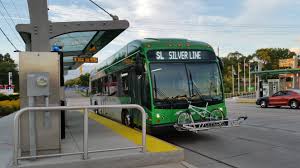By ERIC FREEDMAN
Capital News Service
LANSING – Getting to work every day can be a pain, but the amount of pain varies depending on where you live and how you get to your job.
Traveling by public transportation –still unpopular in Michigan–such as buses and commuter trains often takes twice as long – or more – as driving alone, an analysis of national census data by Governing.com shows.
But, bucking that trend, Grand Rapids has taken up the challenge and reduced bus time commutes.
Meanwhile, walking, on average, takes less time than either other options, according to the study that included seven metropolitan areas in Michigan.
In the Grand Rapids-Wyoming metro area, for example, the average commute is 21.4 minutes for those who drive themselves and 40.4 minutes for public transport riders. In the Kalamazoo-Portage area, solo drivers average 21 minutes each way, compared to 38.3 minutes by mass transit, the analysis shows.
What about across the country?
“The latest census suggests Americans who drive alone spend an average of nearly 25 minutes traveling to work. The national average for bus commuters is 45 minutes, while those who ride subways or streetcars spend an average of 47 minutes traveling to work,” the study said.
Governing.com based its analysis on data from the Census Bureau’s American Community Survey for 2011-2015.
Clark Harder, the executive director of the Michigan Public Transit Association, said public transit commute times in the Grand Rapids-Wyoming area may be shorter now than the figures show. He attributed that to the Silver Line, the state’s first “bus rapid transit” system, operated by Grand Rapids Interurban Transit Partnership.
It’s like “a light rail system on wheels” and “blurring the line between buses and trains,” according to the partnership, which operates the local transit system known as The Rapid.
CDM Smith, a design and construction firm that worked on the $40 million project, said, “Dedicated lanes, which separate buses from traffic, ensure a speedy commute even during rush hour times.”
The 9.8-mile Silver Line route has 34 stations linking downtown Grand Rapids, the city’s Medical Mile and the suburban cities of Kentwood and Wyoming, the firm said. It said that since the line opened in 2014, daily ridership along the route rose 40% while average commute time dropped from 45 to 27 minutes.
Michigan’s car commuters spend a bit less time behind the wheel than the national average of about 25 minutes. Only in the Detroit-Dearborn-Warren metro area is the average drive time – 26.2 minutes – longer than the national average.
As for mass transit riders – which in Michigan means primarily bus passengers – they average a high of 57.5 minutes of travel time in Bay City and a low of 30.5 minutes in Jackson.
Harder said, “We don’t have subways and won’t have any subways. The next-fastest public transportation is rail, and we essentially have no rail in Michigan for public transportation for commuting except, on a very limited basis, the People Mover” in downtown Detroit.
“We’re down to good old-fashioned buses on the same roads cars are running on,” and those roads are “highly congested,” he said.
The study didn’t include the Lansing and Flint metro areas, which Harder described as having the state’s two “most robust services” for transit to work.
The census data shows public transit is far from popular in Michigan.
In four of the seven metro areas studied, only 1% of commuters regularly use public transportation. The highest proportion – still only 2% — is among commuters in the Grand Rapids-Wyoming and Detroit-Dearborn-Warren areas. The user rate in Jackson is close to 0%, the data shows.
The study said, “If transit systems want to attract more riders, they need to find ways to speed up the journey to work.”
Harder said the two most effective things Michigan could do to speed up commutes is to give buses priority to use shoulders and to create HOV – high-occupancy vehicle – lanes on freeways, as some other states do.
“You need to look at opening up the shoulders for bus usage during times of high-congested (traffic) volume,” he said.
The data shows that walking is a time-efficient option for workers who live close to their jobs.
In Michigan, the average walking time commute ranges from a quick 6.5 minutes in Midland to 11 minutes in the Detroit-Dearborn-Wayne area, according to the analysis. The national average is 12 minutes.
“The distance people walk as part of their commute to work is typically less than one mile,” said communications director Jeff Cranson of the Michigan Department of Transportation.
“Because walking is such a localized activity, it is difficult for MDOT to directly support it through programs, grants or policies,” Cranson said, and the department doesn’t have resources directly available to encourage walking as a commuting option.
However, he said the department supports efforts by metropolitan planning organizations to “support clean commute options and programs,” which may include encouragement of efforts to increase walking and public transit use by commuters.
